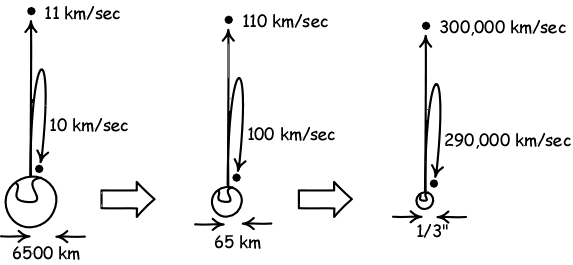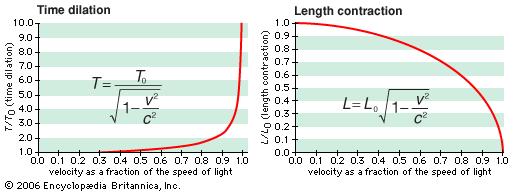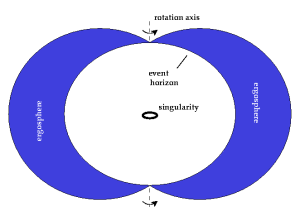Brentley Powell -
Black Hole Physics
Homepage Fundamentals Relativity Thermodynamics Resources
Relativity
|
The concept of a black
hole first publicly proposed by John Michell in
1783. He considered a classical gravitational field
strong enough that the escape velocity was greater
than the speed of light.
"...[it] is therefore possible that the largest luminous bodies in the universe may, through this cause, be invisible." Classical Black Holes
A problem arises with the classical description of a
black hole. As the mass collapses into a singularity,
the light which it emits is still visible to the
outside. Collapsing into an infinitely dense
singularity which interacts with the external
environment would require the release of an infinite
amount of energy.
 Classical, 'Newtonian' black hole with a naked singularity. (from https://www.pitt.edu/~jdnorton/teaching/HPS_0410/chapters/black_holes/index.html) General Relativity Thought Experiment
Consider two aliens named Tik and Tok. Tik remains an arbitrary distance away from Tok, who decides to freefall towards the event horizon of a black hole. Tik and Tok remain within one another's line of sight, so they frequently exchange photons. As Tok accelerates toward the event horizon, Tik sees that Tok's photons have lost some of their energy to the gravitational field of the black hole. The photons have red-shifted to a greater wavelength. This is not what Tok observes. To Tok, Tik and the space he inhabits appear to have been compressed head-on so that his photon maintains its wavelength. He also observes that Tik's photons are blueshifted, gaining energy from the field. As Tok nears the event horizon, he sees time speed up for Tik while his own time remains steady. Tik now sees that Tok seems to be nearly frozen, fading to red, and stretched front-wise. Tok is now being bombarded by high-energy radiation as he observes Tik speed up, the space between them shrunk even further. It would have taken an infinite amount of time for Tik to observe Tok crossing the event horizon.  To Tok, Tik seems to dilate in time and contract in length as Tok is in an accelerated frame. (from from https://www.britannica.com/science/time-dilation/media/596118/86705) Other Properties of Black Holes
According to the No-Hair Theorem, black holes do not
have any variable characteristics other than position,
momentum, mass, angular momentum, and charge. All other
properties of black holes relate to constant factors of
these three physical values. The nature of statistical
distributions makes the probability that a black hold
carries a significant charge very low. However, Angular
momenta of black holes can be quite extreme. Some black
holes have been found to rotate at a speed greater than
84% of the speed of light.
 Rotating black hole with ring-singularity. (from https://galileospendulum.org/2011/09/02/some-further-notes-on-black-holes/) Angular momentum causes rotating black holes to be slightly squashed along their axis of rotation. The effect is that rotating black holes have multiple horizons, and a ring-like singularity rather than a point. The inner horizon acts as the event horizon. Between the inner and outer horizon, objects are forced to co-rotate with the black hole. Within the outermost region, the ergosphere, angular momentum is also transferred through the relativistic frames of objects outside the horizon. Such objects are accelerated radially as they are dragged through space. Rotational energy can be extracted from the rotational energy of such a black hole. See Resources
for full list of sources. |